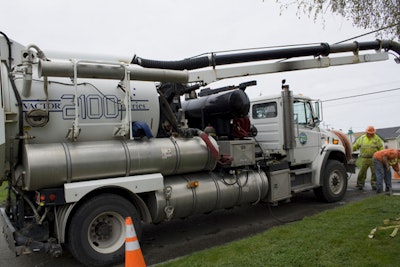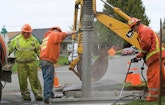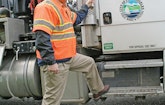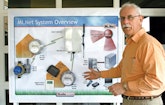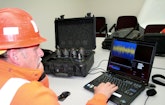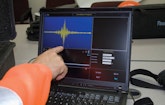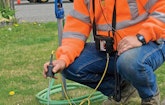
Interested in Infrastructure?
Get Infrastructure articles, news and videos right in your inbox! Sign up now.
Infrastructure + Get AlertsWhen you’re located in a remote, pristine region like the Pacific Northwest, self-sufficiency is vital. The city of Port Angeles, on Washington’s North Olympic Peninsula, has set some high bars to meet its water conservation goals.
Through a multifaceted program of in-house leak detection, meter replacement, system rehabilitation and a dam removal, this community of 20,000 is making a positive impact on its region while benefiting its customers. Each segment of its program is carefully designed to work in harmony with and support the others. The program strikes an excellent balance in meeting residents’ needs, protecting the environment, and providing sustainable water-quality excellence.
Looking inside
Port Angeles lies 70 miles northwest of Seattle. Although it is close to a metropolitan area, it is separated from its closest big-city neighbor by a three-hour drive along Puget Sound. That means Port Angeles had to become a full-service city, providing utilities and other services in an area where private service options were not available.
The city’s Public Works and Utilities department is responsible for the water, wastewater, stormwater, solid waste collection and electricity. Water comes from the Elwha River, fed by glaciers in the Olympic Mountain Range. To protect and ensure sustainability of this key resource, Port Angeles has launched a program to reduce and ideally eliminate water loss from its distribution system in conjunction with mandated Water Use Efficiency (WUE) guidelines.
The city has always had a leak detection program, but it has become more aggressive over the last decade. Until recently, the city used consultants from the Seattle area for leak detection services that included “listening” to the lines, correlating, and reporting findings. The consultant worked once a year, typically for one week.
“Since we are a fairly small, compact community, we were able to do roughly about a fifth of our system each year that way,” says Glenn Cutler, P.E., director of Public Works and Utilities. “Although the firm did an excellent job, our water superintendent, Ernie Klimek, evaluated the value we were getting from the firm.
“He felt that if we purchased the equipment and enabled our crews to do the leak detection, it would be more cost effective for us. In addition, when emergency issues came up, we wouldn’t have to wait hours or even days for somebody to come in from outside of the area.”
More coverage
The annual contract service cost $5,000, and the investment in new equipment was $10,000. Seeing that the payback period was relatively short, the city moved forward and brought that piece of the program in-house. The shift to in-house service was simple and straightforward for the Port Angeles crews.
“The outside firms had been using our crews as a resource on what to look for, how to look, and where the problem areas existed, so the idea was to take our ideas back home, use the same tools and equipment and solve the problems in-house,” says Klimek. “The crews took ownership and liked the results they saw, so it was an easy transition, and the desire to keep up the momentum is strong.”
The crews now cover two to three times more of the system annually and respond to suspected problems more rapidly. They are dispatched weekly or biweekly, depending upon the workload, to a specific area where problems are suspected. For preventive leak detection, crews are typically deployed for the full day and can assess three to five blocks on average.
In the past, the city tried to “save up” a group of points with suspected problems before calling the contractor. Now, since there are no restrictions on time and contract costs, the in-house agency crews can address problems immediately on a case-by-case basis.
The leak detection process involves visual and listening observations. Upon arrival at the site, crews walk the area to look for visual signs of leaks. Then they listen, using ground microphones, following the same path as the walking visual inspection and staying alert for unusual sounds that could signal leaks.
Zeroing in
If crew members observe a potential leak, they correlate it using a ZCorr portable leak detection system by Itron. The unit allows them to strategically target a section of the distribution line and pinpoint leak locations by capturing sounds over a short period with a series of digital correlating loggers (DCLs), placed at intervals along the line.
No excavation is required, and crews can perform listening and correlating from the meter box or from valves. The DCL data is shared with the unit’s digital mapping and analysis software, and the sound data is then processed and uploaded to a laptop computer.
The software provides a graphical readout that portrays the line’s health, detailing leaks and their exact location and severity. The system also tracks the line’s history as assessments are performed, helping the city create an accurate baseline for the system. During the first year of its in-house program, the city documented and eliminated 3 percent of its water loss.
When leaks are found, staff members follow up with immediate and appropriate action. For smaller leaks, crews unearth the lines by hydroexcavation, using a Vactor unit, then install a repair band, or replace the leaking pipe section if required. “We aren’t doing a lot of large major digging these days,” says Klimek. “Our hydroexcavator really is an asset — a great tool for these small repairs. The way we think of it, instead of doing an invasive surgery, we can perform delicate arthroscopic procedures on our system.”
More than location
Aggressive leak detection has helped pinpoint some losses, but Cutler and Klimek felt some unaccounted-for water loss could relate to old and faulty meters. Most of the city’s water meters are approaching end of life, and as part of WUE, all water meters (about 8,600) will be replaced at residential, commercial and industrial sites with units equipped with automated meter reading features that include leak detection.
Funding is being split between existing water and wastewater rates, and customers will not see any special fees or rate increases. “If we have cost increases in the future, or if we can keep all other costs the same, the rate may actually come down because metering will be more equitable across the system,” says Cutler.
“Visualize a brand-new meter being 100 percent accurate, and another meter running at, say, 75 percent. Well, the resident who has a slow-running meter is paying the same cost per cubic foot of water, but they’re not being billed for their full consumption. With the new equipment, these discrepancies are eliminated and cost burdens are accurately shared by all.”
Port Angeles shares consumption history with its customers so they can better manage their water use and learn how to use the resource better. Other conservation measures for customers include high-efficiency showerhead and aerator giveaways.
Under the WUE guidelines, the electric utility has helped cover the cost of energy-efficient appliances that also save water, like washing machines and dishwashers. “The water utility has been able to benefit from those efforts,” says Cutler. “Our overall goal is not just to conserve a natural resource. It’s also to help lower our operating costs, because if we can reduce our losses, that means we don’t have to pump as much water.
“And if you pump less water, there’s less chemicals, less wear and tear on equipment, and less energy consumption. By adopting a ‘help me, help you’ attitude, we’re making conservation painless and easy for customers to get involved in and embrace.”
Protecting the source
Meeting residents’ water and power needs sustainably requires not only aggressive conservation but also a long-term vision of how to protect the drinking water source in a way that benefits the local environment and ecosystems.
Port Angeles derives its water from a well fed by the Elwha River, a major tributary in the North Olympic Peninsula that empties into the Strait of Juan de Fuca. At one time, the Elwha was a major rearing site for many varieties of salmon. In the early 1900s, two hydroelectric dams were built on the river to help supply power for the region.
The dams had no fish ladders, although a rearing channel on the lower dam helped sustain natural salmon habits and procreation. Over the years, fish populations declined, and the dams’ structural integrity came into question. As a result, in 1992, the U.S. Congress passed the Elwha River Ecosystem and Fisheries Restoration Act, calling for the dams’ removal.
A key provision was to protect water quality against adverse impacts of dam removal. Work has begun on a project costing $325 million that includes studies, permits, and building of water treatment facilities for Port Angeles and other water purveyors that depend on the Elwha for water. A ceremony for deconstruction of the dams was held Sept. 16, 2011. It will take three to five years for the river to regain a steady-state condition.
The plan also includes construction of a greenhouse and a fish hatchery, and the replanting of native material in areas exposed when the lakes behind the dams are drained.
Sediment is a big concern for Port Angeles, as when dam removal begins, turbidity in the river will increase. It is also possible that when the dams are removed, the river will migrate away from the city’s well. To compensate, a new water treatment plant will house two processes: direct filtration and a new Actiflo rapid-settling system (Kruger USA).
The Actiflo plant, the first in the state for drinking water, will settle out particles rapidly so that large volumes of water can be processed. During high turbidity after dam removal, the state Department of Ecology will allow the city to harvest surface water. The entire process will take several years with an open-ended timetable for assessment of water-quality impact.
Patience and persistence
Balancing all its projects has been challenging for the city. Some staff members were skeptical at first about bringing some of the work in-house. Would it be beneficial? Would it be cost effective? Would the equipment really be used or just sit on a shelf?
By involving the staff, keeping communication lines open, and being patient and persistent, leadership made it easy for the staff to buy in. That means cost savings for the utility and satisfaction for the team. “The staff lives here too,” says Cutler. “We’re all part of this community, and a sense of pride has developed over what we’re doing, how we’re helping the community, and how we’re doing things in our town to make it better.”
That attitude has helped Port Angeles create a program that works harmoniously and equitably serves residents, the environment and the agency. For those looking to develop a strong conservation and resource protection program, Klimek offers advice.
“Conservation, efficiency, quality, water loss reductions, these aren’t something that will change overnight. People often lose sight that positive and impactful changes take time. Look for solutions not in a short timeframe but in ranges of three to five years. It takes patience. Don’t rush for results. Study your findings, monitor your data, and build baselines. Do that and you’ll truly be able to put your data to work for you and achieve your program goals.”
